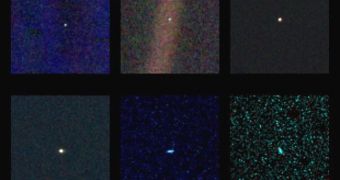The Voyager-1 space probe is most likely one of the most famous machines ever sent into space by NASA. Its name is synonymous with space exploration, and it is currently located far beyond our solar system, investigating the deep Universe. Exactly 20 years ago, on February 14, 1990, the probe sent back its last Valentine for the solar system, snapping an image of the planets as they are arranged around the Sun, from its superb vantage point beyond the orbit of Pluto. While some planets are too dim to be seen on account of their proximity to the star, others are clearly visible.
Investigators who analyzed the photos at the time they were beamed back say all that was visible of Mars was just a thin crescent of sunlight, whereas light coming from Mercury was completely dimmed by the Sun. Pluto was also too dim to make out, but all the other planets, including Earth, Venus, and the four gas giants, were visible. When they were snapped, the images represented a completely new way of looking at our solar system, adding on the already existing data brought back by Apollo astronauts, of how our planet actually looked like.
Voyager project scientist Ed Stone, from the California Institute of Technology (Caltech), in Pasadena, explained that Earth was finally seen in the posture astronomers were expecting it to be, a tiny blue spec in a solar system among countless others. “It captured the Earth as a speck of light in the vastness of the solar system, which is our local neighborhood in the Milky Way galaxy, in a universe replete with galaxies,” he said. The data on the entire system were then added to the groundbreaking images the twin Voyager probes had sent back, of Jupiter, Saturn, Uranus and Neptune. Both spacecrafts were launched in 1977.
“I was struck by how special Earth was, as I saw it shining in a ray of sunlight. It also made me think about how vulnerable our tiny planet is,” said planetary scientist Candy Hansen, from the NASA Jet Propulsion Laboratory (JPL), a NASA facility managed by Caltech. “That's here. That's home. That's us. On it everyone you love, everyone you know, everyone you ever heard of, every human being who ever was, lived out their lives. … There is perhaps no better demonstration of the folly of human conceits than this distant image of our tiny world,” wrote in his book “Pale Blue Dot” the famous astrophysicist and author that was Carl Edward Sagan.
Despite being more than 17 billion kilometers away from the Sun, Voyager-1 is still inside the bubble the star creates around all planets. “We were marveling at the vastness of space when this portrait was taken, but 20 years later, we're still inside the bubble. Voyager 1 may leave the solar bubble in five more years, but the family portrait gives you a sense of the scale of our neighborhood and that there is a great deal beyond it yet to be discovered,” Stone concludes.

 14 DAY TRIAL //
14 DAY TRIAL //